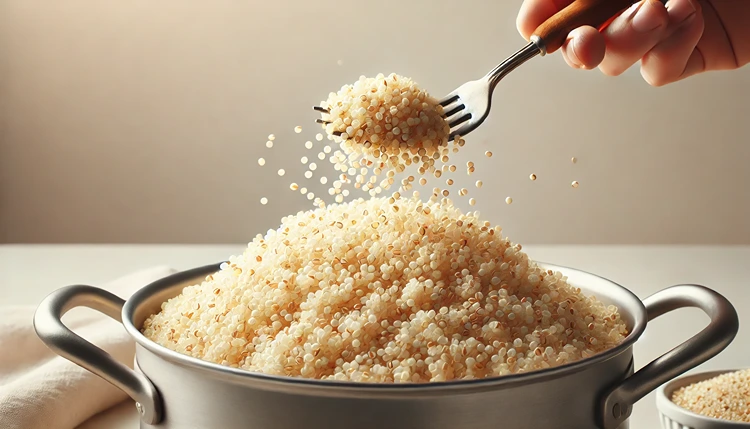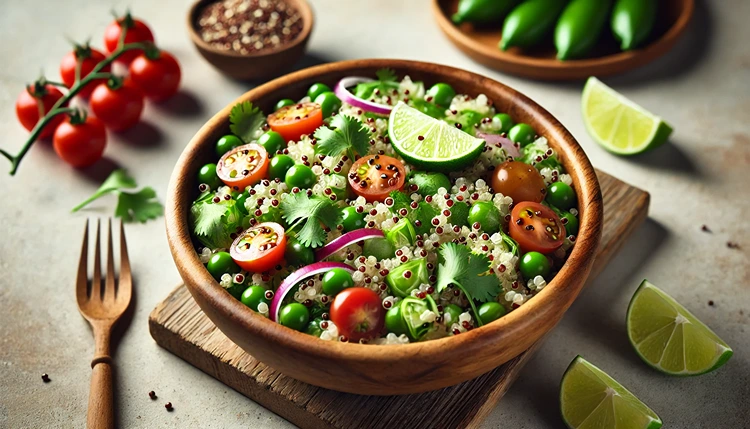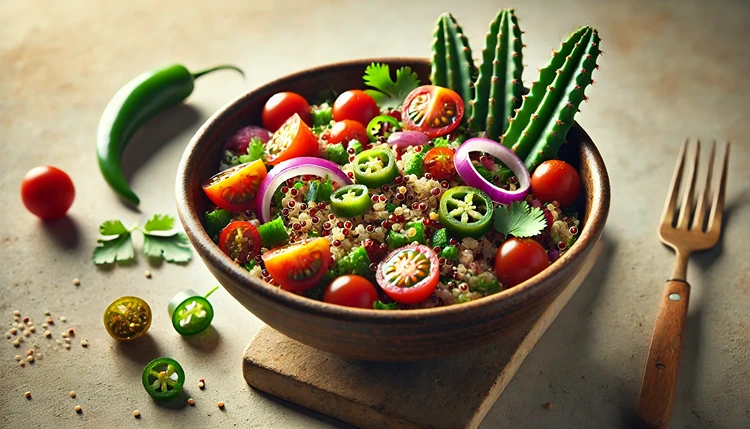When it comes to ancient superfoods, the Aztecs had a pretty solid grasp on nutrition. Foods like quinoa and nopal (cactus) were staples in their diet, offering them both sustenance and a host of health benefits. Today, these ingredients continue to shine in modern kitchens, especially for those seeking vibrant, plant-based meals with cultural significance. In this post, we’ll explore how to make a delicious, nutrient-packed quinoa and nopal salad inspired by Aztec traditions, while adding a few modern touches for flavor and texture.
Why Quinoa and Nopal?
The focus keyphrase “quinoa and nopal salad inspired by Aztec culture” might sound like a trendy dish, but it’s rooted in the culinary history of Mexico. The Aztecs were known for their resourceful use of plants, and both quinoa and nopal played important roles in their cuisine. Quinoa, often referred to as a “super grain,” is actually a seed packed with protein, fiber, and vitamins. Nopal, or prickly pear cactus, adds a refreshing crunch and unique flavor while delivering antioxidants, vitamins, and minerals.
Health Benefits of Quinoa
Quinoa is a powerhouse ingredient, and it’s no surprise that it was cherished by the Aztecs. Packed with all nine essential amino acids, quinoa is a complete protein—meaning it provides everything your body needs to build and repair tissues. It’s also high in fiber, which supports digestion and keeps you feeling full for longer. Add to that a wealth of vitamins, including magnesium, iron, and B vitamins, and it’s clear why quinoa was a dietary staple for ancient cultures.
Why Nopal is a Superfood
Nopal, or prickly pear cactus, has been used in Mexican cooking for centuries. Rich in fiber, antioxidants, and vitamin C, nopal helps support the immune system, lower cholesterol, and regulate blood sugar. Plus, it’s low in calories, making it a perfect addition to salads. The slight tangy flavor and crunchy texture make it a standout ingredient in this quinoa salad.
Helpful Hint:
When preparing nopal, make sure to remove the spines carefully. You can find pre-cleaned nopal in many stores, or you can use a knife to scrape off the thorns if working with fresh pads.
How Does This Salad Honor Aztec Traditions?
This quinoa and nopal salad is more than just a healthy dish. It’s a nod to the ancient Aztec culture that cherished these ingredients for their life-sustaining properties. By combining them in a fresh, modern way, we’re able to appreciate the history while enjoying flavors that fit perfectly into contemporary meals. Nopal was frequently consumed raw or cooked in Aztec cuisine, and pairing it with quinoa brings out the earthiness of both ingredients.

Adding a Modern Twist to Ancient Ingredients
While the Aztecs may not have had access to all the herbs, spices, and dressings we enjoy today, that doesn’t mean we can’t enhance the dish with modern touches. Think of fresh lime juice, cilantro, and a hint of jalapeño for some heat. By using these flavors, we elevate the base ingredients without overshadowing their natural qualities. The balance between tradition and innovation is what makes this salad truly special.
Quinoa and Nopal Salad Recipe
Quinoa and Nopal Salad

Ingredients
- 1 cup quinoa, rinsed
- 2 cups water or vegetable broth
- 1 1/2 cups diced nopal (prickly pear cactus)
- 1/2 cup cherry tomatoes, halved
- 1/4 cup red onion, finely chopped
- 1 jalapeño, seeded and diced
- 1/4 cup fresh cilantro, chopped
- Juice of 2 limes
- 2 tbsp olive oil
- Salt and pepper to taste
Instructions
- Cook the quinoa: In a medium pot, bring 2 cups of water or vegetable broth to a boil. Add the quinoa, reduce the heat to low, cover, and let it simmer for about 15 minutes, or until all the water is absorbed. Fluff with a fork and set aside to cool.
- Prepare the nopal: If you’re working with fresh nopal, remove the spines carefully. Boil the diced nopal in water for about 10 minutes, then drain and rinse with cold water to remove any sliminess.
- Mix the salad: In a large bowl, combine the cooked quinoa, diced nopal, cherry tomatoes, red onion, jalapeño, and cilantro. Toss gently to combine.
- Dress the salad: In a small bowl, whisk together the lime juice, olive oil, salt, and pepper. Pour over the salad and toss to coat.
- Serve chilled or at room temperature. Enjoy!
Notes
If you prefer, you can grill the nopal instead of boiling it for a smoky flavor. This salad keeps well in the fridge for up to three days, making it perfect for meal prep!
How to Serve Quinoa and Nopal Salad
This salad makes a fantastic light lunch or a refreshing side dish for dinner. Pair it with grilled vegetables or roasted sweet potatoes for a heartier meal. It’s also a great option for potlucks and picnics—since it’s dairy-free, there’s no need to worry about it spoiling quickly. The tangy lime dressing, combined with the crunch of the nopal and the fluffiness of the quinoa, creates a texture and flavor combo that’s hard to beat.
Helpful Hint:
If you’re making this salad ahead of time, consider adding the lime dressing just before serving to keep the ingredients fresh and vibrant.
In the next part, we’ll explore variations of this quinoa and nopal salad and dive into the historical significance of each ingredient in Aztec cuisine. Stay tuned!
Variations of Quinoa and Nopal Salad
While the classic version of quinoa and nopal salad is delicious on its own, you can easily switch things up by adding a few other ingredients or trying different combinations. Let’s look at a few variations that you can experiment with based on your taste preferences or what’s available in your kitchen.
Adding Avocado for Creaminess
If you want to add some creaminess to your quinoa and nopal salad, tossing in some diced avocado is a perfect choice. Avocado adds a rich, buttery texture that contrasts beautifully with the crispiness of the nopal and the lightness of the quinoa. Plus, it boosts the healthy fat content of your meal, making it even more satisfying.
Including Beans for Extra Protein
For a more substantial, protein-packed version of the salad, consider adding beans like black beans or pinto beans. Both beans are common in Mexican cuisine and complement the flavors of nopal and quinoa well. Not only does this bump up the protein, but it also adds a hearty texture and earthy flavor to the salad.
Spicing It Up with Chipotle
If you love a bit of smoky heat, chipotle peppers are a fantastic addition to this salad. A spoonful of chipotle in adobo sauce can be mixed into the lime dressing to create a bolder flavor. This variation is ideal for those who enjoy a little spice in their meals, as it brings a smoky depth that pairs nicely with the fresh ingredients.
Historical Significance of Quinoa and Nopal in Aztec Cuisine
While quinoa and nopal have gained popularity in modern cooking, their roots go far back into Aztec culture. Both ingredients were not only valued for their nutrition but also for their adaptability in various dishes.
Quinoa in Aztec Traditions
Though quinoa is often associated with the Inca civilization in South America, it was also used in Central Mexico, where it became a key food source for ancient cultures. The Aztecs, along with other Mesoamerican civilizations, cultivated grains and seeds like quinoa, amaranth, and chia to sustain their communities. These grains were revered for their ability to grow in harsh conditions and their high nutritional content, making them essential in a diet focused on longevity and strength.
Nopal in Aztec Culture
Nopal was a sacred plant for the Aztecs. It appears in their mythology and cultural symbols, representing resilience and survival. The cactus plant was commonly used in both cooking and medicine. Nopal was eaten fresh, cooked, or even dried for later use, and it was praised for its nutritional value, particularly its ability to help regulate blood sugar and provide hydration in the hot, dry climates of Mexico.
Interesting Facts About Quinoa and Nopal
| Fact | Details |
|---|---|
| Quinoa’s Status as a Pseudocereal | Although often considered a grain, quinoa is technically a seed. It belongs to the same family as spinach and beets. |
| Quinoa as an Ancient Crop | Quinoa has been cultivated for over 5,000 years, making it one of the oldest crops still widely consumed today. |
| Nopal’s Hydration Power | Fresh nopal is composed of over 85% water, which makes it a great ingredient for hydration, especially in hot climates. |
| Nopal in Traditional Medicine | In addition to being eaten, nopal has been used in Mexican traditional medicine to treat digestive issues, inflammation, and high blood sugar. |
| Quinoa’s Nutritional Benefits | One cup of cooked quinoa provides 8 grams of protein and is a source of iron, magnesium, manganese, and phosphorus. |
| Nopal for Regulating Blood Sugar | Studies have shown that nopal may help lower blood sugar levels, making it beneficial for those managing diabetes. |
How to Store and Prepare Nopal for the Best Results
Many people are unfamiliar with how to handle nopal, but it’s quite easy once you get the hang of it. Nopal can be found fresh in many grocery stores or Mexican markets. Here are a few tips for storing and preparing nopal at home.
Storing Nopal
Fresh nopal should be stored in the refrigerator, unwashed, for up to a week. Keep it in a plastic bag or airtight container to maintain its freshness. If you’ve already diced it, try to use it within three days for the best flavor and texture.
Preparing Nopal
If you buy fresh nopal with spines still attached, you’ll need to clean it before using it in the salad. Here’s a quick guide:
- Lay the nopal flat on a cutting board.
- Using a sharp knife, carefully scrape off the spines and thorns, being mindful not to press too hard on the flesh.
- Once the spines are removed, rinse the pad under cold water to remove any residue.
- Slice the nopal into strips or dice it into cubes, depending on your recipe.
After preparing, you can either boil or grill the nopal. Boiling will reduce the sliminess, while grilling will add a nice char and smoky flavor.
FAQs
Wrapping Up
Quinoa and nopal salad inspired by Aztec culture isn’t just a nutritious and flavorful dish—it’s also a connection to the culinary traditions of ancient Mexico. By combining the high-protein benefits of quinoa with the crisp, refreshing taste of nopal, this salad offers a unique way to enjoy healthy, plant-based ingredients that have stood the test of time. Whether you’re making it as a light lunch or a side for dinner, this recipe is easy to adapt, bursting with flavor, and rich in cultural history.
Don’t hesitate to experiment with the variations or customize it to suit your taste. The balance of traditional ingredients with modern twists makes this dish perfect for those looking to explore Aztec-inspired cuisine while maintaining a contemporary flair. If you’re curious about more ancient ingredients or looking for more recipes, dive deeper into Mexican culinary traditions to uncover a world of flavor and history.








